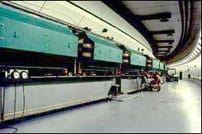Leon Lederman, Melvin Schwartz, and Jack Steinberger, at the time all of Columbia University, made their discovery at the brand-new Alternating Gradient Synchrotron (AGS). At the time, only the electron-neutrino was known, and the scientists wondered if they could find more types of these ghostlike particles that pass through everything. The AGS, then the most powerful accelerator in the world, was capable of producing the beam needed.

The experiment used a beam of the AGS’s energetic protons to produce a shower of pi mesons, which traveled 70 feet toward a 5,000-ton steel wall made of old battleship plates. On the way, they decayed into muons and neutrinos, but only the latter particles could pass through the wall into a neon-filled detector called a spark chamber. There, the impact of neutrinos on aluminum plates produced muon spark trails that could be detected and photographed — proving the existence of muon-neutrinos.
The Nobel committee awarded them the 1988 Nobel Prize for Physics for the neutrino beam method and the demonstration of the doublet structure of the leptons through the discovery of the muon neutrino.